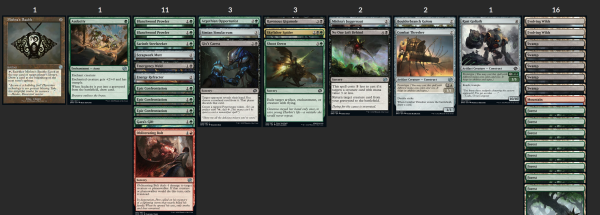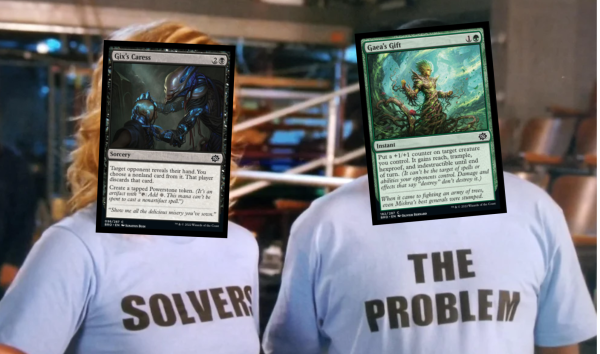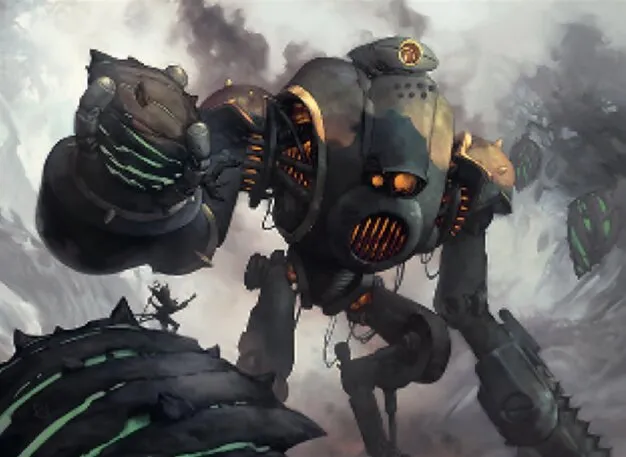Are you a Quiet Speculation member?
If not, now is a perfect time to join up! Our powerful tools, breaking-news analysis, and exclusive Discord channel will make sure you stay up to date and ahead of the curve.
So there I was, struggling to read the table as I clumsily navigated a draft.
Green was open. That much was clear. I collected a number of powerful cards, but lacked a real plan. Citanul Stalwart never showed up, and my options to splash for various win conditions vanished one pick at a time. Next, black looked like an option, then a few red signals came my way, then the deluge of gold cards in distant combinations pointed to all the great possibilities that would not be. I felt like Sylvia Plath, staring at her splattered figs.
The pool had some okay cards, but without a clear plan, the deck was destined to be a mediocre mess. I tinkered with various versions of the deck, looking to leverage my high powered cards as best as I could. There was a diverse collection of tools, but it wasn't particularly aggressive and didn't really have the top end to win at the late stage of the game. For the sake of science, I tested the generally weak No One Left Behind, and if I was going to play a Zombify effect, I wanted something worth the effort.

It had to be done.
Rust Goliath Reanimator (7-1)
Early-Game and Enablers
The developing stages of the game involve generating value from cheap creatures and surviving with cheap interaction. Blanchwood Prowler is the perfect two-drop here. It finds lands, can tussle with the format's many x/1s, and is a body for Epic Confrontation or Powerstone Fracture. Scrapwork Mutt overperforms here as well. While it's nice to get some damage in, our goal is mostly to survive, and trading off serves us well.
Prowler is a perfect partner for unearth creatures. It encourages splashing, as it digs for lands. The unearth cards are eager splashes, as the front side can come down without a single colored mana. While splashing is never truly free, this certainly lessens the risk. This is a strong incentive to be green in any number of shells. Evolving Wilds, Energy Refractor, and Citanul Stalwart all facilitate this game plan nicely.
Green's inherent ability to splash makes it a reasonable home for drafts that have gone off the rails. While we'd prefer to be in something more synergistic, Citanul Stalwart lets you bend those rules of engagement. However, as previously mentioned, we didn't have access to the flexibility the one-drop provides. We would have to work for our wins.
Incidental Value and the Mid-Game
Building up a bank of unearth creatures puts a level of pressure on opponents that can easily be overlooked. If we generate a critical mass, our opponents will eventually look at those creatures as raw damage. As a result, opponents will need to deal with our boardstate more aggressively. Argothian Opportunist and Boulderbranch Golem all perform this role perfectly. They battle just fine, they provide value, and sometimes they'll even eat a removal spell.
At its heart, this deck was a classic GB Value deck. Because of this, trading resources should be a winning strategy in most matchups. Besides, once the dust settles, our 10/10 trampler is going to be bigger than whatever our opponents our doing.
The Problems
Removal is very good in this format and there is a decent amount of it. While our prototype threats duck a lot of the small removal, they die to the various Disenchants in the format. If we're going to do the work required to reanimate an expensive creature, we want to make sure it sticks around.
As we develop, we want to be making trades and pressuring removal. However, sometimes it can help to have proactive approaches. This is especially true because very often we will die on the spot to a Sibling Rivalry.

Gix's Caress and Gaea's Gift protect out gameplan. With these two cards, a resolved Rust Goliath will often go uncontested.
So, Is It Real?
Well, no. Not even close, really.
While we went 7-1 with this pile, the deck lacks reliability. Cards like Emergency Weld or even Loran, Disciple of History can help us get back our creatures, but the only piece we need to have in hand is a sorcery. Besides Arcane Proxy, a mythic rare, the format has zero ways to rebuy an instant or sorcery. While GB Value decks might want to use a Reanimate spell to get back any number of powerful options, this shouldn't be the primary plan.
However, GB Value decks are a great place to be positioned at this stage in the format. A value-based gameplan tied to reanimating threats, gumming up the ground, and relying on some flexible removal spells can make for a reasonable strategy. Weeks back we had little interest in green, but now that the format is maturing, the color has new life.
It's So Easy Being Green
Aggressive decks dominated the first weeks of the format. While red is still the best color and the aggressive decks are still strong, the format evolved due to the self-correcting nature of draft. When a color overperforms, it subsequently becomes overdrafted. This has become true of the most effective decks, especially the very synergistic ones. Fixing goes earlier than it originally did, and many of the glue pieces that overlap in multiple synergies are being targeted with earlier picks. Usually I like to talk about how a format evolves, but this one might actually be devolving.
This Benefits Green More Than Any Other Color
Green has a ton of solid pieces at common, but as far as a true identity goes, it's the most flexible. Many of the green commons are just good-rate creatures that can hold the fort or go on the aggressive. They can play a value game, or back up attacks with a grip full of combat tricks. Green's flexibility and high card quality makes it the perfect tool for the late stages of a format, with or without Citanul Stalwart.
So while the reanimator strategy is probably nothing more than "just fun," green has felt like a safe haven over the last few weeks. Everyone wants to be in red, but green is more of a local secret. Because its best commons fit in so many archetypes, it makes for a good color to settle into in difficult pack ones.
Shine a Little Light
If we're going to spend this much time talking about green, we should focus on its most overlooked piece of interaction.
The first copy of this removal spell is pretty solid in most green decks. It feels like it kills everything (it doesn't). The exile clause is good and between its three legal targets it can get us out of a lot of situations. There is however a huge caveat, and that is the cost. While four mana is a lot, and sorcery speed is an issue, we can build our deck to minimize those problems. However, if we have some one-, two-, and three-drops, Shoot can be a nice addition to our deck. It's not a bomb, but we can feel safe including the first copy almost all the time.
Have you been loving green as much as I? Let me know in the comments.




